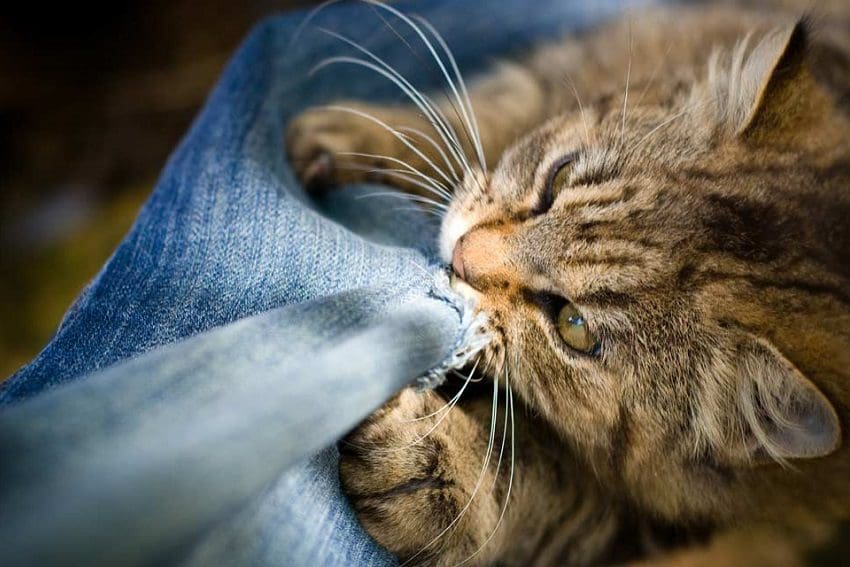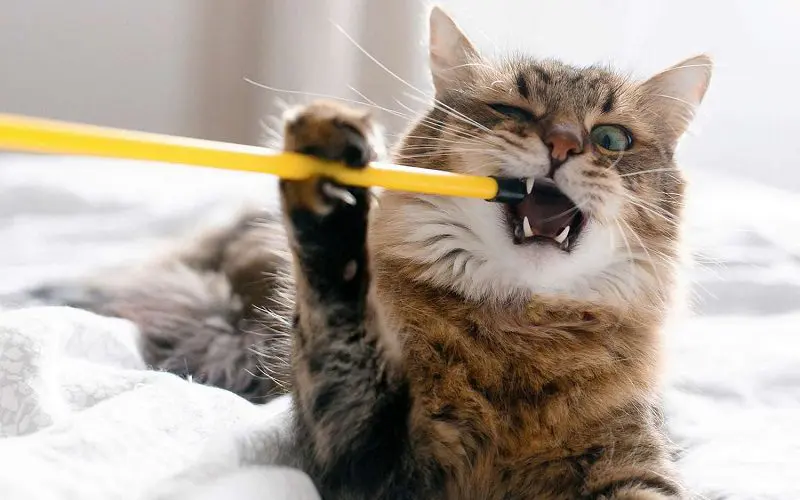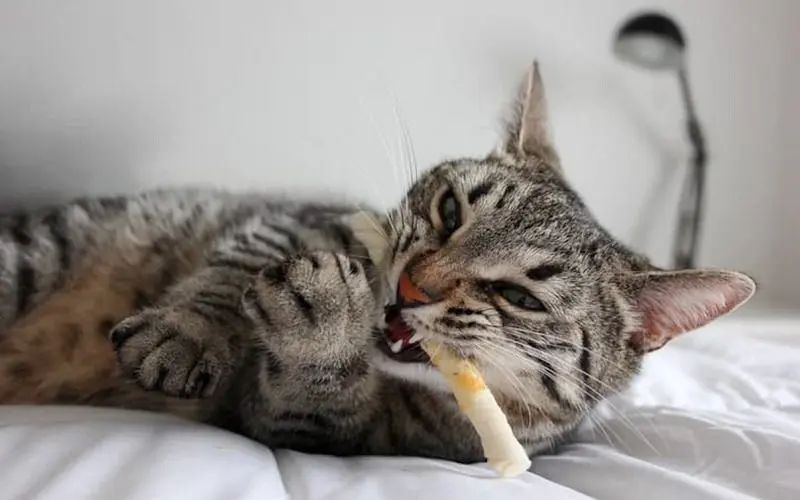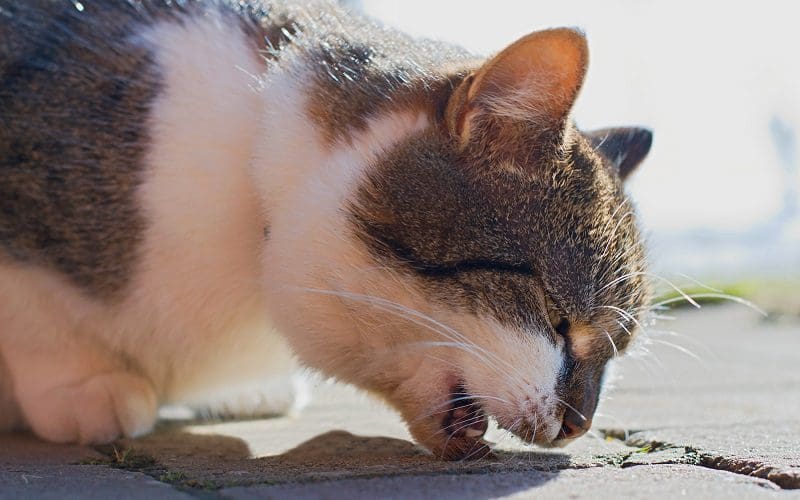Last Updated: 2 years ago
Cats are mysterious and graceful creatures. They often surprise us with their unique behaviors.
One such intriguing phenomenon is the “cat pica.” But what exactly is it? Do our furry friends have this curious condition?
We’ll explore their curious habits and treatments. From eating unexpected objects to deciphering possible causes, we’ll unravel the causes of pica in cats.
Join us on a little journey through the unusual eating habits of our favorite feline companions. Get ready for an educational adventure into the world of pica!
What Is Pica in Cats?

Pica in cats is a peculiar behavior. It tends to cause our feline friends to eat non-food items.
Imagine this: your cat nibbles on things like wool, paper, or even plastic! It doesn’t sound appetizing, does it?
But why is this happening? It can be due to a variety of factors. And you’d be surprised, but more often than not, it’s because of plain boredom!
Imagine that your cat is craving to chew on something unusual. It’s like a mystery novel. And we want to know what’s behind it.
Veterinarians believe observing your cat’s surroundings and enriching their environment with toys and proper nutrition can help curb this quirky habit.
So next time, will your cat choose something unexpected as a snack? Then remember that it’s not just a random choice. Your cat may have a history of having a pica problem!
What Causes Pica in Cats?

If you’re reading this article, you’ve probably caught your curious cat nibbling on strange objects.
This bizarre behavior leaves pet owners puzzled. What causes our feline friends to exhibit such a strange penchant for non-food items?
Let’s understand the causes of this problem. It will help to choose the proper treatment for pica in cats:
- Nutritional deficiencies: Being picky eaters, cats might indulge in pica to fill nutritional gaps. A lack of essential vitamins and minerals can lead them to explore unconventional snacks.
- Boredom and stress: Just like humans may turn to comfort foods, cats might resort to unusual nibbling when bored or stressed. Keeping them mentally stimulated with toys and activities can help alleviate this.
- Underlying health issues: Nibbling can be a sign of an underlying health problem. Dental problems, gastrointestinal disorders, or parasites can trigger this peculiar behavior. It indicates that it’s time to visit the veterinarian.
Owners can better attend to their pet’s needs if they are aware of the underlying issues. You’ll be able to make your home a happier and healthier place to live.
Symptoms of Pica in Cats

Have you noticed unusual behavior in your cat? It is far from an extreme symptom of a problem in a cat.
Recognizing the symptoms is crucial to combating this peculiar feline habit.
Let’s look closer at the signs that your cat may have pica. It will be easier to diagnose pica in the future.
- Chewing on non-food items: The most obvious symptom is that the cat shows interest and actively chews on objects. But they are not food! For example, plastic, paper, or plants.
- Vomiting: Swallowing undigested items can lead to vomiting. Watch your cat’s regurgitations, especially if they contain unusual materials.
- Changes in behavior: Pay attention to any sudden changes in your cat’s behavior. These include increased restlessness, anxiety, or signs of distress. Sometimes, pica in cats can be related to underlying stress.
- Gastrointestinal problems: Diarrhea or constipation may accompany pica. It signals possible digestive problems caused by the ingestion of non-food substances.
- Weight loss: Persistent pica can lead to nutritional imbalances and weight loss. It indicates the need for surgical intervention.
Being alert to these symptoms of pica allows owners to identify pica in its early stages. It facilitates timely intervention and ensures the well-being of their pets.
How to Treat Pica in Cats

Addressing your cat’s peculiar habit of munching on non-food items requires a thoughtful approach. Here’s how you can find treatment for pica in cats:
- Consult the vet: Schedule a vet visit to rule out any underlying health issues causing pica. A thorough examination can identify potential concerns.
- Nutrition check: Ensure your cat’s diet meets their nutritional needs. Your vet may recommend a specific diet or supplements to address deficiencies triggering pica.
- Environmental enrichment: Keep your cat mentally stimulated with engaging toys and activities. Combat boredom to discourage the exploration of non-edible items.
- Safe alternatives: Offer safe chewing alternatives, like cat grass or appropriate toys. This kind of treatment for pica in cats will help kick the habit.
- Behavioral modification: Employ positive reinforcement for good behavior and discourage pica gently. Consistency is key to reinforcing positive habits.
A combination of veterinarian recommendations and a balanced diet will help you manage it effectively.
An additional stimulating environment will help cure your feline friend’s pica.
How to Diagnose Pica in Cats

Diagnosing pica in cats involves keen observation and professional guidance.
Here’s a straightforward guide:
- Behavioral observation: Watch for unusual behaviors like chewing on non-food items, excessive licking, or vomiting.
- Vet consultation: Visit the vet to discuss your cat’s peculiar habits. The vet will perform a thorough examination.
- Medical history review: Provide your veterinarian with your cat’s medical history. Describe any recent changes in diet, environment, or daily routine.
- Blood tests: When asking how to diagnose pica, the veterinarian may perform blood tests. They will check for nutrient deficiencies or underlying health problems.
- Imaging studies: In some cases, the doctor recommends imaging studies. This way, they will rule out any blockages or abnormalities.
It is important to combine observation with professional knowledge. It ensures a comprehensive diagnosis of pica in cats, paving the way for effective management and treatment.
Recovery of Pica in Cats

Recovery from pica in cats is achievable with patience and a tailored approach.
- Vet guidance: Follow your vet’s advice closely. They may recommend specific dietary changes, supplements, or medications to address underlying issues.
- Environmental changes: Create an environment with interactive toys and fun activities. This way, your cat will forget about the causes of pica in cats.
- Safe substitutes: Offer safe alternatives for chewing, like cat grass or designated toys. Redirect their attention away from non-food items.
- Consistency is key: Implement consistent behavioral modifications. Reward positive behaviors and gently discourage pica’s habits.
- Regular check-ups: Schedule follow-up visits with your vet to monitor progress and adjust the treatment plan if needed.
If you use all the recommendations together, your cat can get rid of the symptoms of pica. They will lead a healthier and happier life.
Conclusion
Understanding and eliminating pica in cats involves many factors.
Regular checkups with a veterinarian, a nutritious diet, and providing the cat with exciting alternatives for chewing contribute to recovery.
Pet owners can teach their feline friends healthy habits with patience and consistency. Remember that every cat is unique.
Therefore, an individualized approach to its needs will guarantee a positive outcome for the perfect person in overcoming pica.
Resources:
